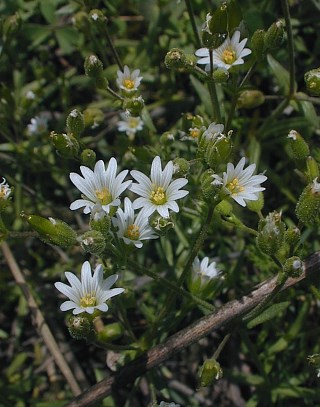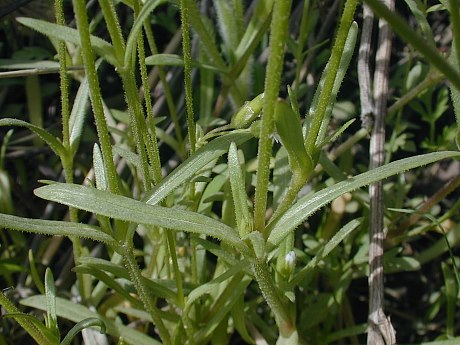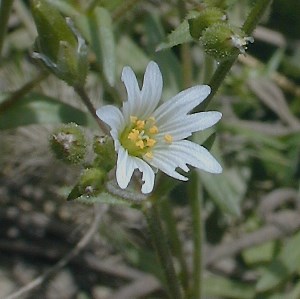Description: This plant is a winter or spring annual about 4-16" tall that sometimes branches from the base, forming a tuft of leafy stems. Each erect to ascending stem is light green to pale purplish green, terete, and evenly glandular-pubescent. Several pairs of opposite leaves occur along each stem; sometimes tufts of smaller leaves develop from the axils of the lower opposite leaves. These leaves are up to 1" long and 1/5" (5 mm.) across; they are linear, linear-oblong, or oblong, and sessile against their stems. Each leaf is hairless on the upper surface with a single prominent vein; the lower surface is also hairless, except for some glandular hairs along the central vein. The leaf margins are smooth and ciliate.

Each stem terminates in a corymb (flat-headed cluster) or compound corymb of flowers. The peduncle of each corymb is similar to the stem, except that it has a pair of leafy bracts at its base; it can be several inches long. Compound corymbs have branched ascending peduncles. Each flower is up to ¼" across; it has 5 white petals, 5 green sepals, 10 stamens, and 3 tiny white styles at the apex of the light green ovary. The petals are cleft at their tips, while the sepals are glandular-pubescent. The pedicel of each flower is up to ½" long and glandular-pubescent. The leafy bracts are linear-lanceolate to ovate, glandular-pubescent on their undersides, and slightly membranous along their margins at maturity; they are smaller in size than the leaves (½" long or less). The blooming period occurs during the late spring and lasts about 3 weeks. There is no noticeable floral scent. Each flower is replaced by a cylindrical seed capsule that is up to 10 mm. (3/8") long. At maturity, this seed capsule becomes membranous and open at its apex; there are 6 small teeth along its upper rim. There are numerous small seeds within each capsule; each seed is pale brown, minutely warty, ovoid-obovoid in shape, and somewhat flattened. The root system consists of a slender branching taproot with fine fibrous roots. This plant spreads by reseeding itself and occasionally forms colonies.

Cultivation:
Typical
growing conditions consist of full sunlight and average levels of
moisture. Three-styled Chickweed adapts readily to loam or clay-loam
soil; sandy or gravelly soil may be tolerated as well. Because this
chickweed is taller and more erect than most, regular mowing may
inhibit its spread.
Range & Habitat:
The adventive Three-Styled Chickweed is a rare weed in Illinois; it has
been observed
in only a few counties of south-central and east-central Illinois (see Distribution
Map). This species is native to southern Europe and parts of
Asia. The earliest collection of this species in the United States
occurred in the state of Washington during the 1960's. Since that time,
it has been observed in several other states (both eastern &
western) and appears to be spreading. Habitats include disturbed areas
with low grassy or weedy vegetation and the upper slopes of ditches.
Recent construction activity may have introduced this species
to
Champaign County in Illinois.
have introduced this species
to
Champaign County in Illinois.
Faunal Associations:
This information applies to chickweeds, both native and introduced,
that are typically found in sunny meadows and similar habitats. The
nectar and pollen of the flowers attract small bees (Halictid &
others) and flies (Syrphid & others). The caterpillars of the
moths Agrostis venerabilis (Venerable Dart), Haematopis
grataria (Chickweed Geometer), and Lobocleta
ossularia (Drab Brown Wave) feed on chickweeds. Among
vertebrate animals, the seeds are a source of food for the Mourning
Dove and various sparrows, while the foliage is occasionally eaten by
the Cottontail Rabbit.
Photographic Location:
The upper slope of a drainage ditch in Urbana, Illinois. If the
photograph of the flower close-up is examined closely, it is possible
to see the 3 tiny white
styles; they are surrounded by the yellow anthers of the stamens.
Comments:
Among Cerastium spp. (Mouse-Eared Chickweeds), this
chickweed is highly unusual because its flowers have 3 styles, rather
than 5 styles. This characteristic is more typical of Stellaria
spp. (Chickweeds). However, other characteristics of its
flowers (e.g., the presence of 10 stamens & the shape of its
petals) and the even pubescence of its stems are more typical of the
Mouse-Eared Chickweeds. Three-Styled Chickweed is a little taller than
most of these species and its leaves are more slender. Otherwise, it is
rather ordinary looking. Another common name is Doubtful Chickweed,
which is derived from the scientific name.